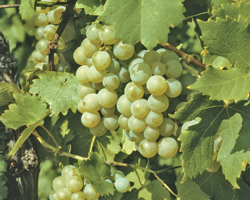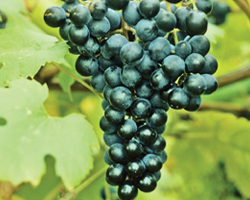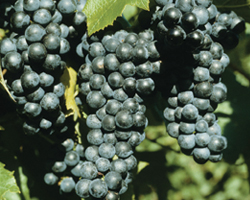
Features
Fruit
Production
Cornell releases three new wine grapes
Cornell University recently released three new wine grap
March 26, 2008 By Joe Ogrodnick
Cornell University recently released three new wine grapes.
The three new grapes – Noiret™, Corot noir™ and Valvin Muscat™ – were developed and tested by Bruce Reisch, grape breeder
 |
| Cornell University grape breeder Bruce Reisch has developed three new wine grapes varieties. Photo courtesy of R. Way, NYSAES, Cornell University |
Cornell University recently released three new wine grapes.
The three new grapes – Noiret™, Corot noir™ and Valvin Muscat™ – were developed and tested by Bruce Reisch, grape breeder and professor of horticultural sciences at the New York State Agricultural Experiment Station in Geneva, New York, in co-operation with Thomas Henick-Kling, professor of enology at the Experiment Station and leader of Cornell’s enology program.
Corot noir™, a mid- to late-season red wine grape, is a complex interspecific hybrid resulting from a cross made in 1970 between Seyve Villard 18-307 and Steuben.
“All three grapes are broadly adapted to the wine growing regions in the East, and produce high quality varietal wines that are superior to those currently available to Eastern growers today,” says Reisch.
Noiret™ (pronounced nwahr-ay), a mid-season red wine grape, is a complex interspecific hybrid resulting from a cross made in 1973 between NY65.0467.08 and Steuben.

|
| Valvin Muscat™ |
 |
| Corot noir™ |
 |
| Noiret™ Photos courtesy of Bruce Reisch, NYSAES, Cornell University |
“Noiret™ represents a distinct improvement in the red wine varietal options available to cold-climate grape growers,” says Reisch. “Wines are free of the hybrid aromas typical of many other red hybrid grapes. The distinctive red wine is richly coloured and has notes of green and black pepper, with raspberry and mint aromas, and a fine tannin structure.” Care should be taken to grow Noiret™ on sites less susceptible to extreme winter temperatures and downy mildew, notes Reisch.
Corot noir™, a mid- to late-season red wine grape, is a complex interspecific hybrid resulting from a cross made in 1970 between Seyve Villard 18-307 and Steuben.
“Corot noir™ is a distinct improvement in the red wine varietal options available to cold climate grape growers,” says Reisch. “Wines are free of the hybrid aromas typical of many other red hybrid grapes, and can be used for varietal wine production or for blending. The distinctive red wine has a deep red colour and attractive berry and cherry fruit aromas.”
Valvin Muscat™ is a mid-season white wine grape with a distinctive muscat flavour and aroma that is desirable for blending as well as for varietal wines. The complex interspecific hybrid grape resulted from a cross made in 1962 between Couderc 299-35 (an interspecific hybrid known as Muscat du Moulin) and Muscat Ottonel.
“Valvin Muscat™ is recommended for the production of high quality muscat wines,” says Reisch. “Vines are well suited to good grape growing sites in the Eastern United States, and should only be grown on suitable rootstocks.” Some care should be exercised to control disease, and fruit should be picked when the muscat flavour reaches its peak, he notes.
Noiret™, Corot noir™ and Valvin Muscat™ are the seventh, eighth and ninth wine grapes respectively to be released by the experiment station. Previous wine grape releases from Cornell include: Melody, Horizon, Cayuga White (grown widely throughout New York and beyond), Chardonel (now the number two grape in Missouri), Traminette (quickly gaining in popularity throughout the East), and GR7 (used in red wine blends).
Vines of the three new grapes are available from licensed commercial nurseries. Contact B.I. Reisch for a list of sources. Commercial nurseries may be licensed by contacting Cornell Research Foundation, 20 Thornwood Drive, Suite 105, Ithaca, New York 14850 (phone: 607-257-1081; fax: 607-257-1015; email).
Print this page